Dear Friend and Reader:
Most people think of the nuclear incident at the Fukushima Daiichi power-generating station as something that happened in the past. You don’t see it mentioned on network or cable news, and it’s not on most news websites or in major newspapers.
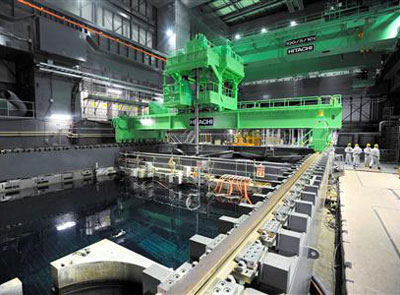
You may have heard that in March 2011, Units 1, 2 and 3 at the Fukushima plant experienced total meltdowns after an earthquake and tsunami crippled the cooling systems of the nuclear reactors.
What you probably have not heard is that in each unit, more than 200 tons of radioactive material got so hot that it turned to lava and melted through the containment structure and into the ground under the plants. It’s currently unaccounted for and is threatening the water supply for 40 million people in the greater Tokyo area.
The most recent mention of anything related to the Fukushima situation in The New York Times was an editorial one month ago focusing on the politics of nuclear power in Japan, with the former prime minister saying he was now in favor of a total ban. The editorial mentioned that a large majority (76%) of Japanese citizens are now opposed to the continued use of nuclear power plants.
On Nov. 11, The Washington Post carried a short item about wind-generating stations off the coast of Fukushima, and the next day referenced the same issue that the Times covered in its editorial — how the former prime minister is urging a nuclear power ban.
If you’re not actively researching the topic, or reading news outlets with a specific focus on the issue, you would think it’s over and done with — and have no way to know that the worst may be ahead.
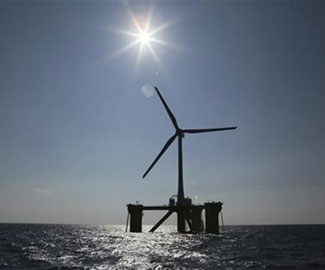
For example, if you’re following Energy News, you might have noticed they carried this Reuters article about structural damage at Fukushima Unit 4.
It’s more likely you were watching CNN a week ago Thursday night, and saw a program called Pandora’s Promise that assured the world that nuclear power is absolutely safe, and that it is the only thing that can save the planet from global warming.
Instead of real news reporting about a serious, immediate issue, we got an extended infomercial for nuclear power that was packed with more lies and omissions than I could count.
Nuclear power is an obsolete technology. One of the most interesting things I learned this week is that the last nuclear power plant to be commissioned and put online was ordered in 1973. That’s correct: the most recent nuclear reactor to be put online was ordered 40 years ago. That’s because nuclear power is simply not financially tenable. The industry had its meltdown long before Three Mile Island had its meltdown in 1979.
The Unit 4 Spent Fuel Problem
The most significant Fukushima-related issue that the news is barely mentioning involves the spent fuel pool that’s dangling in the air above the Unit 4 reactor — fuel that engineers hope to remove beginning this month. If successful, removal of the fuel will be the first real mile marker in what may be a 40-year process of fully decommissioning the Fukushima plant. But engineers have a long way to go before they get there.
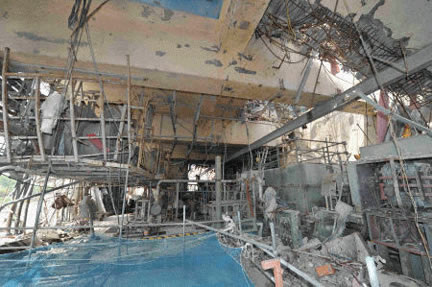
The Fukushima Daiichi station had six reactors: Units 1, 2 and 3, all of which melted down, were operating at the time of the quake and tsunami; and Units 4, 5 and 6, which were shut down for inspection at the time of the quake and tsunami. That means their fuel had been removed and was being stored in the reactors’ spent fuel pools, the bottom of which is located 60 feet above ground level. Both new and recently used nuclear fuel must be stored under water at all times, to keep it cool, to prevent it from burning up and to shield against radiation.
In all, Unit 4’s spent fuel pool has 1,331 old fuel assemblies and the 204 working ones that had been removed for the inspection process. Spent fuel is not radioactive enough to boil water efficiently, but it’s still fissionable; that is, even though it’s ‘used up’, it can reach critical mass and a reaction can start. The spent fuel pool is outside the reactor’s containment structure and there are no control rods to slow down any reaction that may start. Worse yet, the used fuel contains many radioactive isotopes that make it more toxic than new fuel — for example, it’s contaminated with types of radiation that attack specific organs, such as the bones or the thyroid gland.
Unit 4 sustained serious damage as a result of events that started with the earthquake. Units 3 and 4 shared a common ventilation system. The meltdown in Unit 3 released hydrogen gas, which caused that reactor to explode. Some of the hydrogen got into Unit 4, which experienced an explosion that badly damaged the structure. This has left hundreds of tons of nuclear fuel suspended above the Earth in a building that is listing over, and is vulnerable to another earthquake. In addition, the fuel removal equipment was damaged beyond repair, and the spent fuel pool was filled with debris that fell from the partially collapsed building.
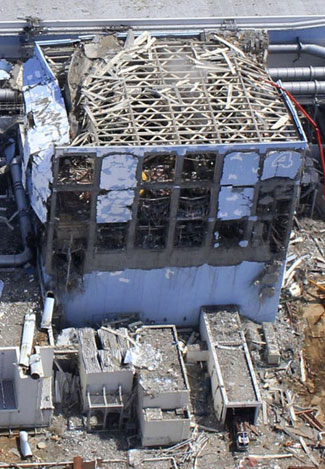
The main problem is that if the water leaks out of the pool, or if an earthquake causes the partially collapsed building to give way, the fuel will be exposed. It will likely catch fire, and critical mass (nuclear fission) will resume. There would be no way to control or contain such an event.
Engineers have known for a while that they have to get that fuel out of there, though between delays and the extensive preparations necessary, it’s taken till now to be ready to begin.
Since the March 11, 2011 quake, there have been 12 aftershocks or quakes in the region of the plant, which the damaged structure has thankfully survived.
There is, in effect, a race against the clock to get the 1,534 fuel assemblies out of the spent fuel pond and onto safer ground before a large earthquake knocks the building down, taking more than 400 tons of highly radioactive material with it.
But this is an extremely dangerous process. The fuel assemblies must be under water at all times, or they will overheat. The water also prevents the fuel assemblies from ramping up their radioactive reaction and keeps them from reaching critical mass. Fuel rods within the assemblies are coated in an explosive, flammable metal (zirconium alloy), which cannot be exposed to the air, overheat or make contact with anything else.
If one small thing goes wrong, we could experience a disaster "of hemispheric proportions," in the words of Paul Gunter, who heads the organization Beyond Nuclear.
By that, he means that a radioactive plume created by hundreds of tons of fuel burning would be far worse than the original incident at Fukushima and deliver a deadly stream of contamination to North America in a matter of days.
Such an event would also render the entire Fukushima site off-limits to people, yet every individual issue at the site requires constant human intervention. If the site is so radioactive that no humans can manage it, the situation will inevitably get far worse.
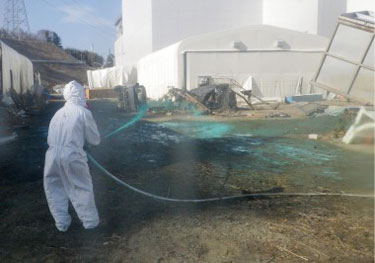
For example, there are an additional 6,375 fuel assemblies in a spent fuel pond that was used by all six reactors. It’s located so close to Unit 4 that a chain reaction could be set off if there is a loss of control of the nuclear material during the Unit 4 procedure.
"The key is getting that first domino not to fall," Gunter said in a Planet Waves interview this week [listen to the full interview here]. But he said he’s concerned that TEPCO — the Tokyo Electric Power Co. — is still in charge of the situation.
"We run an unparalleled risk to put this in the hands of the utility that brought us this problem and that has a record for obfuscating and falsifying safety records in order to cut financial corners," he said. "Really, this should be in the hands of an independent group of scientists and engineers with total transparency. But we are not going to be afforded that level of care."
TEPCO exercised astoundingly bad judgment in developing the plants. During construction, it removed 80 feet of natural grade that would have protected the site from the tsunami, by the ocean in a tsunami zone. This was done for the convenience of moving construction machinery in and out, and so that it would be cheaper to pump water into the plant.
The utility moved the reactor site closer to the ocean, and then planned only for a maximum 10-foot tsunami when the one that struck the plant was 40 to 50 feet high.
We All Live Downwind from the GE Mark 1
It’s easy to think that because this is happening in Japan, it cannot really hurt people in other parts of the world. But when the radioactive plume was first released in March of 2011, it reached North America in a matter of days.
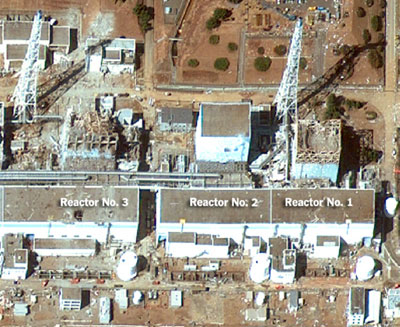
EPA data shows that the highest U.S. levels of radioactive Iodine-131 (I-131) in drinking water after March 17 were found in Philadelphia. I-131 is a direct product of a nuclear meltdown.
Philadelphia, in the part of the U.S. furthest from Japan, also reported a 48% increase in the mortality rate for babies immediately following the incident.
Joseph Mangano, executive director of the Radiation and Public Health Project, said, "Philadelphia infant deaths reported to the CDC [Centers for Disease Control, a U.S. government agency] averaged 5.0 per week for the five weeks ending March 19. The average jumped to 7.4, a 48.0% increase, in the following 10 weeks." Other American cities experienced infant mortality rate increases, but Philadelphia had the highest level of increase. Gunter, the director of Beyond Nuclear, said he’s concerned that the public will not have access to accurate information if something goes wrong.
"Once they lose control of the nuclear reaction, typically with all these accidents — Three Mile Island, Chernobyl, Fukushima — they seek to control the information," Gunter said. "And that is where we remain behind the information curve. The lack of transparency, the fact that Tokyo Electric Power Company who ultimately were responsible for the cost cutting that led to the vulnerability that now has us in this potentially hemispheric catastrophe — they are in charge of this potentially hemispheric catastrophe. They are in charge of this very precarious game of pick-up sticks with these radioactive fuel rods."
The problem potentially can come home in other ways as well. The type of nuclear plant that failed at Fukushima Daiichi, called the General Electric Mark 1, is widely used in the United States. There are 23 Mark 1 reactors at 16 locations in the U.S. The Mark 1 is high on the long list of things that should be a scandal but are not.
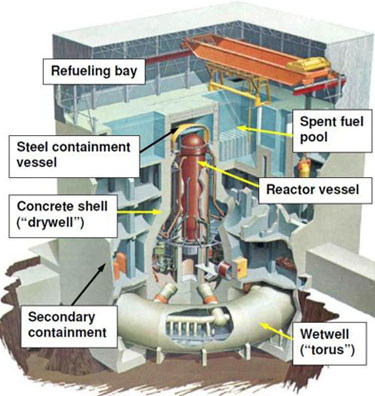
The problems with these reactors were so well established, Gunter said, that in 1976 three General Electric engineers resigned their positions because they knew that the Mark 1 was not a quality product. Gunter called the design a "pre-deployed booby trap."
Among other strange design features, the reactors have their spent fuel ponds high above the ground, where they can fall to Earth, especially in an earthquake zone. The backup generators for this type of plant are in the basement. This was done even when the plants were installed in a tsunami zone, right on the water. When the wave came, they flooded instantly — that’s why they were destroyed at Fukushima, resulting in failure of the backup power, then the cooling systems, and thus leading directly to a meltdowns of the reactors.
And their control rods are inserted upwards from underneath, which requires electric and hydraulic power, rather than having them drop down from above with the help of gravity. Except for an atomic bomb, the Mark 1 seems to be the stupidest thing ever invented, with each unit loaded with 200 tons of uranium or uranium/plutonium mix.
According to a March 2011 New York Times article in response to the Fukushima incident, in 1972, Joseph Hendrie, who would later become chairman of the Nuclear Regulatory Commission (NRC), said it would be a good idea to ban the design. But he said that the technology had been so widely accepted by the industry and regulatory officials that "reversal of this hallowed policy, particularly at this time, could well be the end of nuclear power."
This is atomic logic at its purest: save the plant design, to save nuclear power itself — and threaten the planet.
The Nuclear Axis: It’s About Saturn
The astrology of the nuclear issue is one of the most interesting and revealing astrological case studies I’ve ever encountered.
The base chart for astrological nuclear studies is set for the time of the first self-sustaining nuclear reaction, which took place at 3:25 pm on Dec. 2, 1942 in Chicago. Scientists know this as Chicago Pile 1, an experiment that took place beneath Stagg Field at the University of Chicago under the supervision of none other than Enrico Fermi. This chart is sometimes called the Nuclear Axis because its backbone goes across Gemini-Sagittarius; that is the axis.
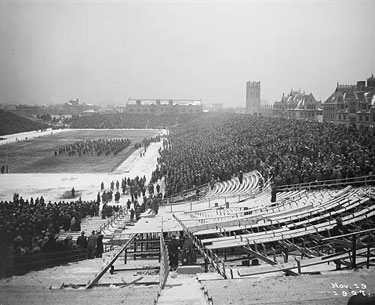
In May, I was made aware by Mark Lerner, former editor of Welcome to Planet Earth, of a controversy involving the time zone. For years, astrologers who used this chart used Central War Time (the equivalent of Daylight Savings Time). Once the U.S. entered the war, the whole country was on War Time, including at the time of the experiment in 1942.
However, documentation has recently surfaced which states that the time of 3:25 pm should be in Central Standard Time. [Those curious may refer to footnote 995 in The Book of World Horoscopes by Nicholas Campion, 2004 edition, which explains the issue.]
Both charts have Taurus rising, so by the classical whole-sign house method, the houses remain the same. Over the past few weeks I have looked closely at both of the Nuclear Axis charts (original and revised) and checked them against several major nuclear incidents, including the first atomic bomb test in 1945 (the Trinity Test), the bombs dropped on live targets in Japan, Three Mile Island, Chernobyl and several others.
The revised (CST) chart has some validity, but it does not leap out as being inherently correct or better than the original chart (in CWT). Based on my research so far, I can find no compelling astrological reason to change the time zone. Note that a one-hour shift of the time zone does not change the positions of the planets by more than a fraction of a degree; rather the change moves the ascendant forward by about 22 degrees.
Besides the original chart standing up to years of use, and the gut check, there’s at least one compelling reason to keep it: the positions of two of the original three centaur planets. The original (CWT) chart has Nessus on the ascendant and Pholus on the midheaven.
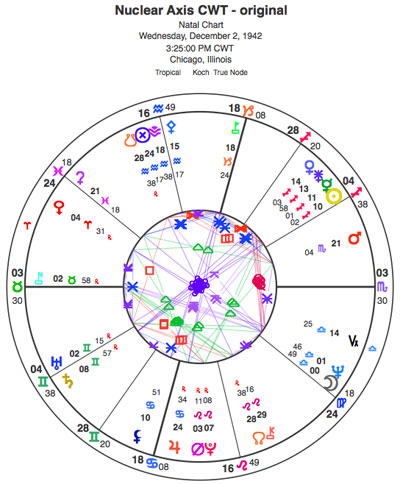
I have seen these points turn up angular for significant disasters enough times that they are making a clear statement in the CWT chart. Understanding Pholus and Nessus seems essential to understanding the nuclear issue.
Nessus, which tells the story of the manifestation of karma in a cyclical way, is an important planet in the nuclear charts. Nessus is about what is inflicted on someone (in the myth, a poison) that comes back to kill the original poisoner. The bottom line with Nessus is, who ultimately takes responsibility? That’s the name of the game with nuclear issues: everyone is trying to pass the buck. When the time comes for someone to take responsibility, it’s a little too late.
Pholus, which is about the release of something that cannot be re-contained, and multigenerational issues, is on the midheaven in Capricorn, right at the beginning of the 10th house of government. The nuclear endeavor is very much a government enterprise. It is not profitable. Industry cannot afford to pay for the results of nuclear disasters. Government is involved in every step of the process. But it has no magical power to stop a meltdown or to contain radiation.
This whole issue of the Nuclear Axis chart and what it says (along with the time controversy) deserves an extensive article or even a monograph. For now, I’ll note that I am aware of the one-hour time discrepancy, I am tracking both charts and for now, I’m sticking to the original CWT chart.
The ‘axis’ in the nuclear axis runs across Gemini and Sagittarius, occupying the first 15 degrees of those signs. When planets come along and make transits to the axis, nuclear incidents seem more likely to occur.
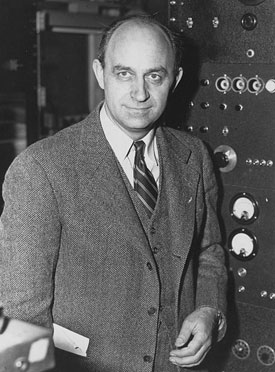
The most sensitive point in the Nuclear Axis chart appears to be Saturn. It’s placed at 8+ degrees of Gemini. And, with dependable consistency, in most of the charts for nuclear incidents, Nuclear Axis Saturn is taking a transit — sometimes even from transiting Saturn. Currently, Chiron is square Nuclear Axis Saturn.
Neptune is in early Pisces now, making a wide square to nuclear axis Saturn (this transit will be exact in March 2015). Later that year, Saturn arrives at 8+ Sagittarius, opposing Nuclear Axis Saturn. So we will be dealing with this for a while — and 2015 promises to be an extremely important turning-point year for the nuclear issue. From the look of the chart, it could be the time of another major incident, since that Saturn is so sensitive.
One of the most compelling current transits to the Nuclear Axis chart is that Neptune, currently in Pisces , is exactly square Nuclear Axis Uranus in Gemini. That is the picture of a disinformation campaign. We cannot trust anything we’re hearing now, which is very little — with nuclear issues, no news is bad news.
Or as was the case with Pandora’s Promise, the purported documentary turns out to be a propaganda film, designed to obfuscate the issue entirely, deny the dangers and push an antiquated technology on the public.
Neptune making a square to Uranus is also the picture of uranium (Uranus) breaching containment (Neptune penetrates boundaries; neptunium is also a radioactive element). And perhaps the most troubling picture this aspect presents is denial of the dangers of radiation, and denial of the fact (Neptune) that these accidents happen spontaneously (Uranus). Everything can go great for 30 years, then one day the plant blows up. With nuclear power, precedent has very little value.
The Fukushima Chart
Let’s check in with one other chart and see if we can find a message. That’s the chart for the earthquake on March 11, 2011. What is remarkable about this chart is that Uranus is at 29 degrees of Pisces and 57 minutes, at the very, very, itty, bitty, last little tip of the zodiac.
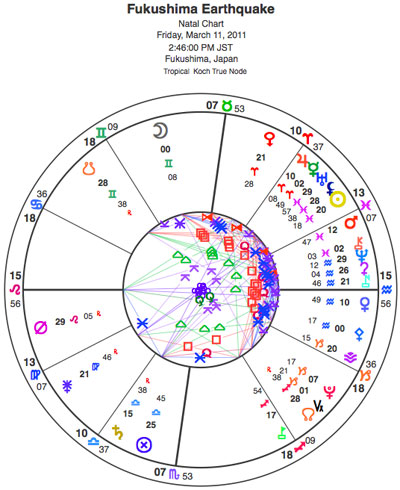
It’s just hours away from making its final ingress into Aries. The chart is set for 2:46 pm Tokyo time, which is about 12 hours ahead of New York time. I remember that night well — for some reason I woke up at about 3 am and turned on the television and saw the news report, which of course said that there were a lot of nuclear power stations in the area but that everything was fine.
Here is our first blog post from that morning, by Karl Grossman, which explains the problem with vivid clarity, describing the chain of events likely to unfold.
In the earthquake chart, the nuclear axis is loaded — Neptune, Chiron, Mars, Pholus and the Moon are all there. Saturn in the Fukushima chart is making a square to Pholus in the Nuclear Axis chart.
There are many other aspects, and both the Nuclear Axis and the Fukushima charts are taking many transits now. Perhaps the most unusual bit of astrology surrounding Fukushima happened the week before. Exactly one week before the incident, I published my first article on the planet Borasisi, a Kuiper object just a bit past Pluto. I called the article With Love from Borasisi.
The article addressed the lies of science and why people are so often inclined to believe them. Borasisi comes from the Kurt Vonnegut novel Cat’s Cradle. He was inspired to write this while working as a PR man at General Electric. The book is essentially a GE-inspired protest against the bomb. The nuclear power industry was essentially a jobs program for scientists who had developed the atomic bomb once the war had ended. In the article, I commented on my personal knowledge of GE’s ethics.
If I were to call up the GE public relations department right now and say, "Hello, I’m a reporter. Are PCBs toxic?" they would fax back a press release that says they’re no more toxic than table salt. That is GE, and this attitude — along with all the lies connected to the atomic bomb — is what propelled Vonnegut to write Cat’s Cradle. He says so in this interview.
One of his comments is that science is supposedly interested in pursuing ‘the truth’, but doesn’t care what happens with the results of its discoveries. In the interview, he gives the example that ‘the truth’ is what exploded over Hiroshima.
I continued:
Vonnegut challenges his readers with the idea that [the lies of religion] are actually fairly harmless contrasted to the ‘truths’ of science. He’s not exactly offering any commendations to either, just showing us the contrast. The lies lead to people being temporarily happier. Truths lead to mushroom clouds and Superfund sites so large nobody knows how large.
One week later, the GE-designed nuclear power plants in Fukushima blew up — and now we have a problem so large we don’t know how large.
We know that ocean contamination has reached northern Alaska and may have immediately caused a spike in infant deaths in Philadelphia. Radiation knows no boundaries. This is in reality a problem without a solution.
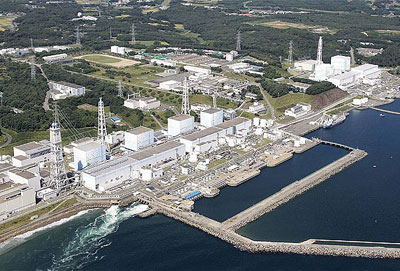
It’s a situation that might be mitigated, but which we’ll have to deal with for the rest of our lives. We might be able to prevent future problems — some world leaders do seem to be catching onto this, such as Angela Merkel in Germany, who shut down her country’s nuclear plants after Fukushima happened.
The nuclear issue is the result of science: that is to say, science without conscience, oblivious to common sense right down to the existence of gravity, which has devised the most expensive conceivable way to boil water, with hundreds of them strewn around, often placed on fault lines, any one of which could one day easily contaminate the entire Northern Hemisphere. As Paul Gunter of Beyond Nuclear pointed out, electricity is the "fleeing byproduct" of a nuclear plant. The real product is radiation, which future generations will inherit having seen no benefit of the electricity that was generated.
The fuel removal from Unit 4 is set to begin sometime in the next week or so; nobody knows exactly when. Enormous preparations have been made to secure the process. This webpage explains the process, and don’t miss the video that gives a nice illustration of how it will be done — and makes it seem really simple, and assures us that nothing could possibly go wrong.
Not even an earthquake.
Lovingly,

This article was the result of months of research conducted by Planet Waves Alpha Class interns Elizabeth Michaud and Chad Woodward. You can find some of that research here, including a good selection of nuclear incident charts. Special thanks to Dr. Karl Grossman.
PS — I didn’t cover half of what I wanted to cover in this article. I will be back next week with a discussion of food contamination and why you don’t want to eat any fish out of the Pacific Ocean or anything at all from Japan.



